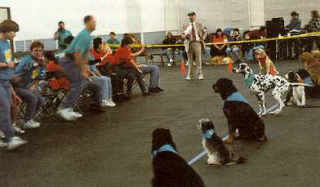Musical Chairs

Musical Chairs is a doggy variation of the classic children’s game. Music plays as handlers walk with their dogs off-leash counter-clockwise around a rectangular area. A line of chairs (with alternating chairs facing in opposite direction) runs down the centerline of the rectangle. When the music stops, the handlers instruct their dogs to sit by verbal request and/or hand signal only, (i.e., without touching them), and rush to sit on a vacant chair in the center of the rectangle. Musical chairs is meant to be a non-contact sport; with the exception of two human rear ends making contact when attempting to sit simultaneously on the same seat, physical contact with any dog or other competitors is not allowed.
The dogs must remain in sit-stays outside of the rectangle. If a dog breaks his sit-stay, or if any part of the dog’s body causes a Line Fault by cutting the line of the rectangle, (paw-faults and tail faults included), the handler must vacate their chair and completely leave the rectangular area to re-sit their dog without contact before trying to find an empty chair once more.
There are always fewer chairs than handlers. The chair-less handler may attempt to get other dogs to break their sit stays by sweet-talking, calling, offering food treats, and by generally acting silly. However, the handler must not use any dog’s name and they must not touch or frighten any dog. Once all of the chairs are occupied by handlers whose dogs remain in sit stays outside of the rectangle, the handler left standing is eliminated. One chair is removed from the line and the next round begins. The top two qualifiers from each round go into the Final.
Training Tips
Playing musical chairs teaches dogs two of the most useful pet dog skills — a lightning-fast, off-leash, emergency Sit plus a rock-solid Sit-Stay. When dogs are successful at playing Musical Chairs, they will take a quantum leap in terms of their quality of life because when owners have such a high degree of off-leash control, they are much more likely to take their dogs to dog parks and on off-leash walks.
Also, dogs with prompt and reliable Sit-Stays are likely to be given full-run of the house, rather than being locked away when visitors arrive. Dogs with reliable Sit-Stays are just much more fun to live with. A quick Sit and solid Stay prevent or resolve well other 90% of possible behavior and training problems because sitting and misbehaving are usually mutually exclusive activities. For example, your dog cannot jump-up, chase his tail, chase the cat, practice agility in your living room, dash out the front door, or lunge on leash and sit at the same time. When in doubt, just say, “Sit!”
Musical Chairs is played off-leash and handlers are not allowed to touch their dogs, so that owners are encouraged to achieve verbal, off-leash, and distance control over their dogs. If owners were allowed to tug on the dog’s leash to encourage him to follow, or to push on the dog’s rump to prompt or coerce him to sit, they would come to rely on leash-tugs and rump-pushes and so, would have no control over their dog if he were off-leash and out of hands reach. When a dog is off-leash, at a distance and looking away from his owner, verbal control is essential.
To gain a competitive edge in Musical Chairs, heel your dog on your right-hand side to keep him as far away from the rectangle when walking counter-clockwise, then he will be less likely to cause a Line Fault when you hustle towards the chairs when the music stops. Whereas, if your dog heels on your left, he will likely sit very close to the Fault Line of the rectangle.
In the earlier rounds, ask your dog to sit and make sure he is in a solid-stay before calmly walking to the line of chairs. In the earlier rounds, a chair will always become available. Dogs will likely be breaking sit-stays every which way but loose. The goal is to qualify for the Final. However, in the Final, your dog will need to sit immediately after the music stops and you give the command while running for a chair. Lure/Reward training is by far the best way to achieve such speedy distance control.
When first watching Musical chairs, many people ask whether it is fair for the chair-less competitors to try and get other dogs to break their Sit-Stays, especially when the chair-less people call the dog, “Puppy, come here,” when they say and signal “Down!” and when they enticingly waggle or toss a food treat. Of course it’s fair! Not only is it fair, but also, ultra-proofing a dog’s Sit-Stay is one of the most important training exercises. For example, let’s say your dog is off-leash in the dog park and suddenly, you notice that some unthinking owner is holding the gate wide open and your dog is rushing towards the street. You instantly shout, “Rover, Sit” and your dog immediately and obediently screams to a halt in a Sit-Stay. However outside the park a little girl is calling her dog in a sweet voice, “Come here, Molly. Come on puppy. Come and get a cookie.” Do you want your dog to remain in a Sit-Stay, or run out of the park to the little girl? Obviously, we would like the do g to remain in a Sit-Stay, that’s why we proof dogs to respond only to commands, that are preceded by their name and to ignore all others. When you instruct your dog to Sit-Stay, you do not want him to respond to other people. Similarly, if you live with more than one dog and say, “Rover, Sit. Fido, Come,” you want Rover to sit and Fido to come, not vice versa. A dog has a name for a reason and so; let’s use it prior to every command where a reliable response is essential.




